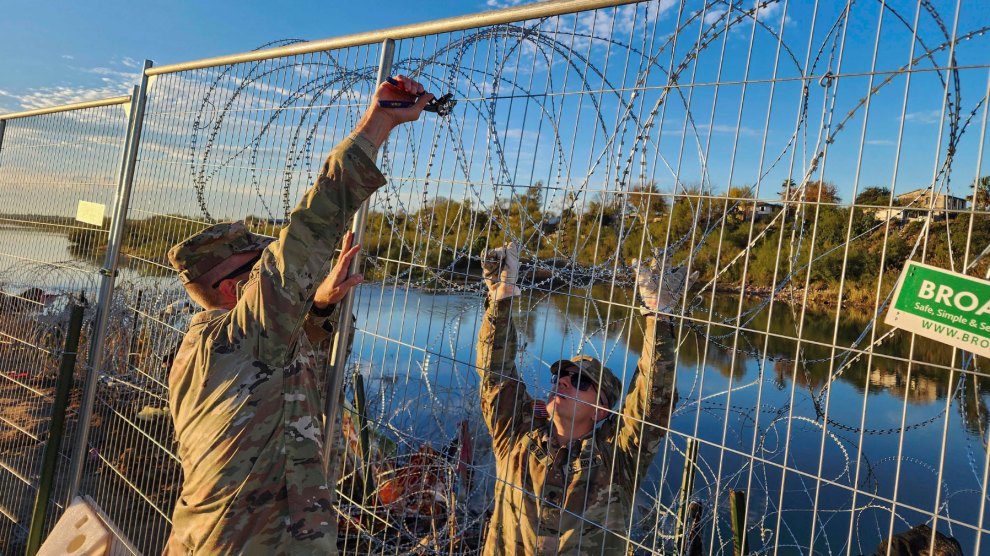For our September+October issue, we investigated the Border Patrol’s sharp growth, its troubling record on civil liberties, its culture of impunity, and its role in shaping the current political moment—one that echoes the anti-immigrant fever that led to the agency’s creation a century ago. Read the whole package here.
The National Border Patrol Museum, which sits inside a squat building on a decommissioned bombing range on the edge of El Paso’s Franklin Mountains, has a musty and scattershot feel, as if one of America’s most troubled law enforcement agencies has just emptied its pockets at the end of a long, hard century.
Seized and donated artifacts fill every available nook—a hang glider and DIY motorcycles used to haul drugs; a collection of ladders and climbing ropes for scaling fences. There is riot gear belonging to the Border Patrol agents who, deputized as US Marshals, helped James Meredith integrate the University of Mississippi. Near the entrance, looking a little lost, is a miniature Statue of Liberty that once belonged to the Immigration and Naturalization Service. The museum, which is privately operated but enjoys a close relationship with the agency, is the final resting place of both Rocky, the drug-sniffing dog, and a remote-controlled robot called “R.A.D.”—short for “Robot Against Drugs”—that was introduced to schools in 1988. R.A.D. carried a squirt gun in its holster “to teach children not to play with guns”; it could also turn into a walk signal.
Taken together, the museum’s exhibits and ephemera tell a simple story—of rugged, honorable men holding the line against disorder. Here, border security and immigration have been flattened into a binary of perps and heroes, and the agency absorbed into a kind of law-and-order monoculture. At the gift shop, alongside shot glasses embedded with bullets, you can buy a T-shirt with the “Thin Green Line” motif overlaid on the logo of Punisher—the serial-killing Marvel vigilante—or emblazoned on a Star Wars stormtrooper.
On the day I visited, an ex-agent-turned-influencer had stopped by to show off a new, promotional gun. The line of “100th anniversary Tribute edition” rifles, available to active-duty or retired members for as little as $800, were a “token of support,” according to the Henry firearms company, for an agency on the front lines of an “ongoing national security border crisis.”
The story of the Border Patrol’s founding offers a lesson for the century that followed, and a rejoinder to the agency’s modern myth: Chaos is not just the absence of a border; it is also the consequence of trying to maintain one.
This image of the Border Patrol as a bulwark against anarchy is central to its identity. “If you don’t have a border, you don’t have a country,” former President Donald Trump often tells supporters. But we have not always had a Border Patrol. For much of the country’s existence, the southwestern border was guarded sporadically. Well into the 20th century it was hardly demarcated at all. Almost no one was searching for unauthorized immigrants because relatively few people were barred from entering. That dearth of rules at the federal level instilled a certain kind of order—when you can cross at a port, there is no need to die in the desert. It took nearly 100 years for the United States to pass its first major federal immigration restrictions. It was another half-century before there was a permanent force dedicated to policing them on the international boundary. Someone had to create it. His name was Claude Benton Hudspeth.
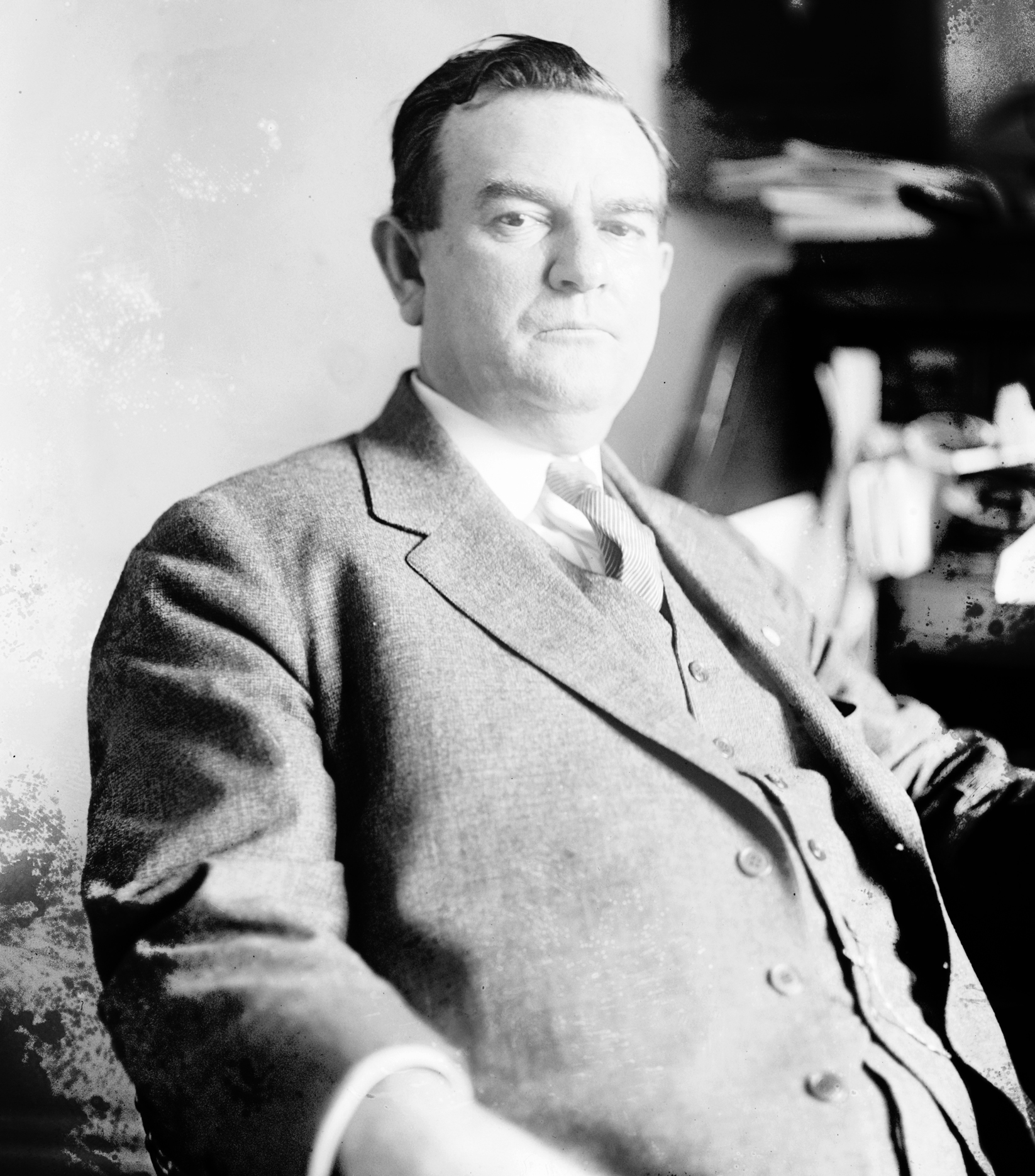
The efforts of a mostly forgotten rancher-turned-congressman from West Texas are worth reckoning with today because the debates on immigration and border policing from a century ago never ended. The Border Patrol was born out of migrant panics, drug wars, and clashes between saber-rattling states and the federal government. It was an era of mass deportations, suspensions of civil liberties, vigilante murders, and calls for an invasion of Mexico. The agency, and the landmark immigration-reform bill that nudged it into existence in May 1924, were backed by eugenicist politicians who feared a Great Replacement by “undesirable” immigrants. The story of the Border Patrol’s founding offers a lesson for the century that followed, and a rejoinder to the agency’s modern myth: Chaos is not just the absence of a border; it is also the consequence of trying to maintain one.

To his contemporaries, Hudspeth was a kind of living relic, a “cowboy statesman” with less than a year of formal schooling who walked with a limp for most of his life on account of a steer-roping accident in his youth. He campaigned for office atop a pony named Sitting Bull and once took leave from Congress to lead a herd of Herefords several hundred miles across West Texas to a newly acquired ranch. As he rose to become one of the most powerful men in the state, that background served as more than political window dressing. It formed the backbone of his politics.
The son of a county sheriff, Hudspeth spent his formative years running sheep and cattle on South and West Texas ranches that had, in recent memory, been violently wrested from Mexicans and Indigenous peoples. A sense of deadly disorder lurking across the line was instilled early. During a 1919 floor speech calling for a military occupation of Mexico, Hudspeth described riding across the Rio Grande with “peace officers” as a boy to retrieve stolen livestock. When he was 19, in 1896, in an episode that seems ripped from a John Ford movie, he and a brother assembled a crew and rode hundreds of miles to Ciudad Juarez to spring their half brother from jail. They claimed he was unjustly imprisoned; the evidence suggests he had a penchant for cattle rustling.
At the time, crossing the river to stage a jailbreak was just a thing you could do. The border of Hudspeth’s youth bore little resemblance to the militarized surveillance state of today. The federal government had only begun to seriously restrict voluntary immigration in 1875, when it barred Chinese contract laborers and women “imported for the purposes of prostitution” from entering the country. As late as 1891, Harvard University professor Erika Lee writes in her history of Chinese exclusion, At America’s Gates, the California-Mexico border was patrolled by exactly three customs agents, whose primary focus was livestock. Alcohol was legal, and the federal government interfered little in the day-to-day comings and goings of many borderlands residents. There was no such thing as unlawful entry. Except for the Chinese, who were forced to present detailed paperwork upon their arrival, no one even needed passports.
As late as 1891, the California–Mexico border was patrolled by exactly three customs agents, whose primary focus was livestock.
This border was permeable, but the idea that it was “open” is also a myth, says University of Virginia historian S. Deborah Kang. In the absence of a large federal immigration bureaucracy, Kang notes, states and territories imposed their own rules, deporting undesirable Irish and restricting the movement of African Americans; the 1881 Chinese Exclusion Act—which banned almost all Chinese, not just contract laborers and “immoral” women—was passed only after California spent years attempting to accomplish the same thing. The US Army, whose far-flung units were sometimes referred to as a “border patrol,” powered white expansion by invading Mexico (on the pretext of defending a disputed boundary) and waging genocide against Native Americans. “And then on top of that, you have a lot of private violence or vigilante violence being deployed by settlers in that region,” Kang says. “Today, historians all see those forms of policing, whether public or private, as forms of border policing.”
In Texas, complaints that the federal government wasn’t doing enough to secure its border were foundational. The state had even cited Washington’s failure to secure the border “against the Indian savages” and “the murderous forays of banditti from neighboring Mexico” in its 1861 articles of secession. By the time Hudspeth arrived in Austin in 1906, as a state senator representing 800 miles of the Rio Grande, a few dozen of the state’s most infamous lawmen had assumed much of the responsibility for patrolling the boundary. The Texas Rangers had been formed to keep enslaved people in and Indigenous peoples out. Hudspeth had briefly served with the Rangers, and he saw its members as the embodiment of what a border police force could be.

Hudspeth spent his first years in office on matters of hyperlocal concern, pushing a bounty on wolf pelts and a ban on competitive cattle-roping. But the start of the Mexican Revolution in 1910 brought the interests of fellow ranchers and white borderlands residents to the forefront of state and national politics. At first, the dynamic on the border was inverted—federal troops tried to prevent Mexicans from leaving the United States to foment insurrection back home. But as refugees and raiding parties began heading north, white Texans demanded a more militant defense of their property.
Just like their antebellum predecessors, Democrats in the state now rewrote their platform to demand the government protect them from “depredations by marauders from Mexico.” And much like Gov. Greg Abbott today, Texas’ actions were openly belligerent—feuding with Washington and threatening violence against Mexicans on both sides of the river. Hudspeth called for military intervention against the “lawless, howling mob” running Mexico and more funding for the men patrolling the border. Texas pushed to triple the size of the Ranger force and demanded President William Howard Taft pay for it. At one point after the state mobilized its National Guard, according to the historians Charles Harris and Louis Sadler, the War Department feared that Texas was actually going to invade Mexico.
“If the federal government does not protect the border with troops,” Gov. Oscar Colquitt said in 1913, “the state of Texas will.”
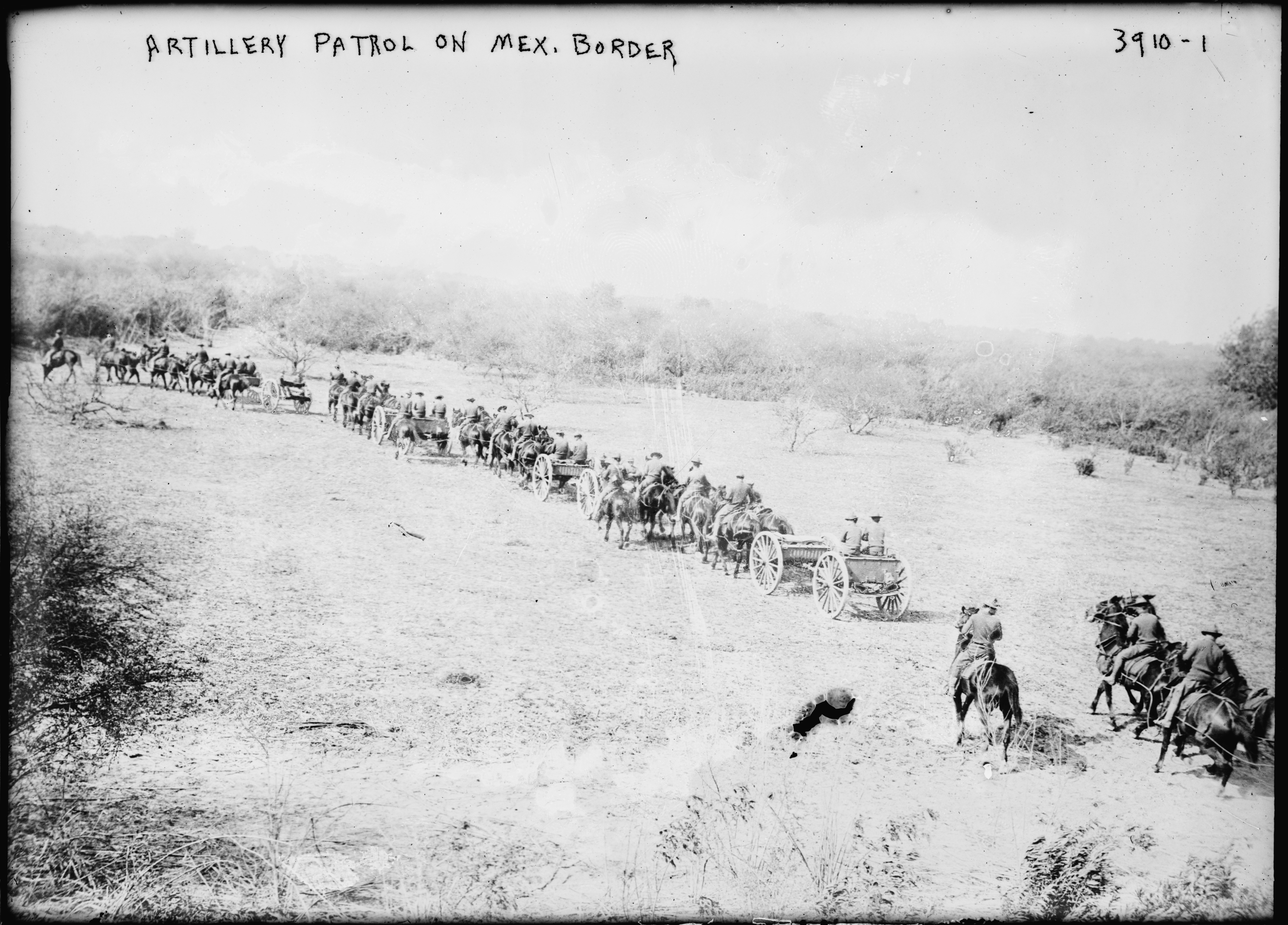
Mexican revolutionary Pancho Villa’s 1916 attack on Columbus, New Mexico, followed a year later by the United States’ entry into World War I, injected urgency and resources into the situation. Fearing a Mexican alliance with Germany, and a full-scale invasion of the Southwest, President Woodrow Wilson’s administration sent more than 100,000 soldiers to the border and dispatched scores of immigration agents and intelligence officers to watch for subversives—namely, German spies, Bolsheviks, and anarchists. In Arizona, a sheriff conducted a mass deportation of 1,000 striking mineworkers—many of them Mexican nationals—citing their support from the International Workers of the World and fears that they were allied with Villa. Meanwhile, Texas’ state government decided to build the border force it always wanted. In April 1917, Hudspeth pushed through a bill allocating $250,000 for 1,000 new Rangers, and an expanded National Guard. At his request, the state even created a special Ranger company, composed of ranch hands in his district. They were called the Hudspeth Scouts.
This was border policing as Texas had always practiced it, less a matter of a line on a map than of identity and power.
For Hudspeth, by now one of the state’s biggest ranchers, the unrest on the border was personal. Several of his constituents had been killed during “bandit” raids, including an old friend from his cowboy days. Rangers had been posted to his land. It was, undeniably, a dangerous time to run a ranch in the borderlands. But the Rangers protected the livestock and lives of white Texans by killing a lot of people and trampling the rights of those of Mexican descent. This was border policing as Texas had always practiced it, less a matter of a line on a map than of identity and power. Rangers seized firearms from Hispanic citizens. They shut down newspapers. In 1918 at Porvenir, a remote Rio Grande village in Hudspeth’s district, a force of Rangers, local ranchers, and U.S Cavalry, lined up 15 men and boys in the middle of the night and shot them.
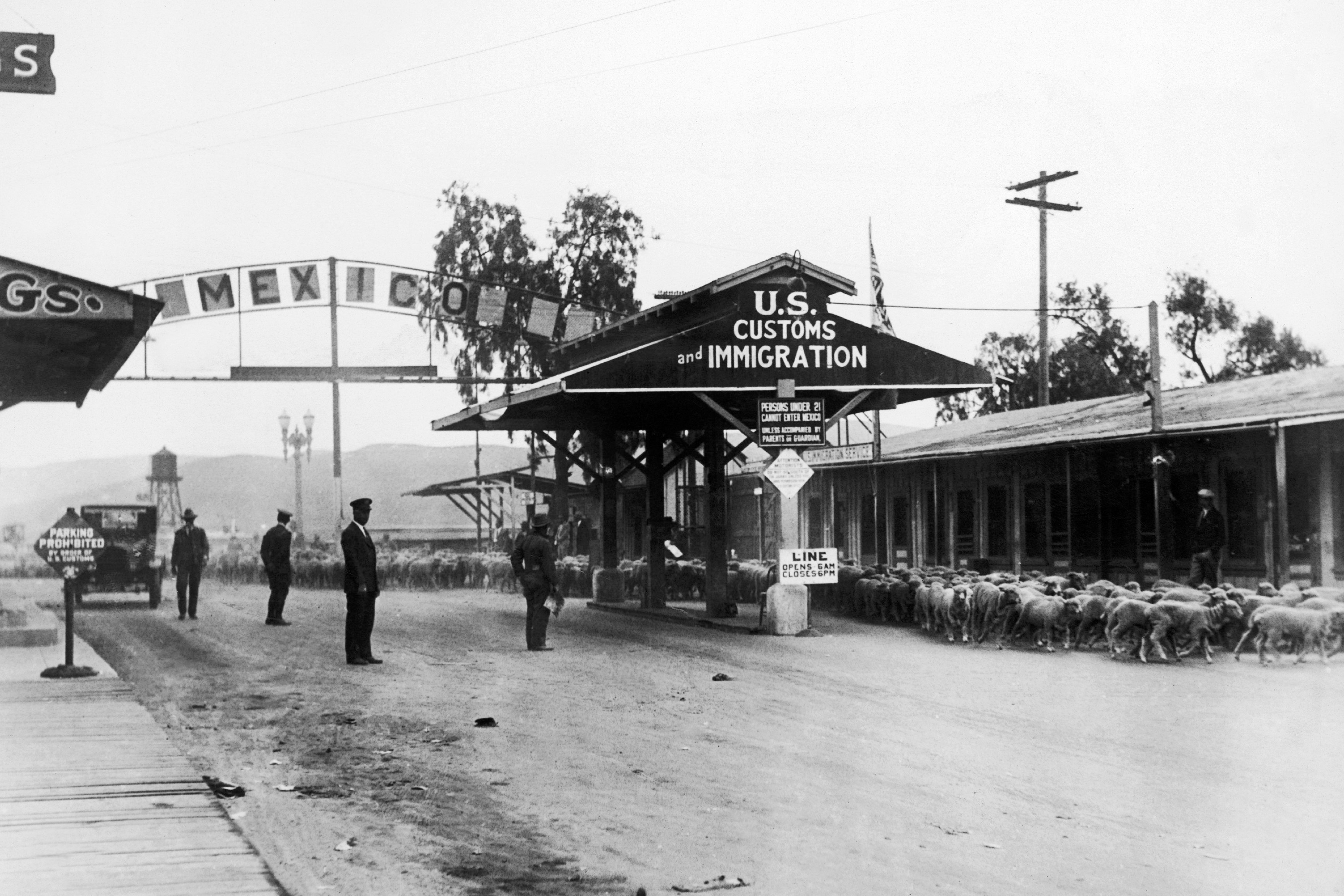

When the legislature convened hearings on the Rangers’ brutality in 1919, Hudspeth, who was about to go to Washington as a newly elected member of Congress, stopped in Austin to defend the force.
“You cannot handle those Mexicans with kid gloves, not when they come 12 miles below El Paso and steal a milch cow every night or two,” he said. His prescription was simple: “You have got to kill those Mexicans where you find them.” The Porvenir massacre, he claimed—in defiance of the facts—was the work of honest lawmen and “good citizens” who were simply protecting their property.
Hudspeth was playing a familiar part. He was, in a sense, the original Beleaguered Rancher of contemporary newscasts—sunburnt and sober, defending not just his property but, he intimated, the civilization that people like him had clawed out of the brush. (How they had clawed it away was not a matter to dwell on.) His constituents talked of moving their ranches 100 miles inland and sending their families away for safety. Without the Rangers, Hudspeth argued, the entire region might as well be ceded to the Mexicans. Increasingly, he and many others with far different backgrounds were starting to insist that if you didn’t have a patrol, you couldn’t really have a border.

While Texas was taking matters into its own hands, Hudspeth arrived that spring at a Capitol that was preparing to tackle the border crisis head-on. In response to the Mexican Revolution and the Great War, Washington had shifted into overdrive to protect itself against the threat of an actual invading army. Now, a group of Democrats and Republicans wanted to go much further. The “invasion” they feared wasn’t from soldiers or cattle thieves. It was from immigrants.
There had long been rumblings that the federal system for detecting the “surreptitious” entry of people was insufficient. Difficulties enforcing the Chinese Exclusion Act had led to the creation, in 1904, of a small Mounted Guard whose members were known as “Chinese Inspectors.” By 1914, the US Immigration Service argued that “contraband traffic and illegal entry of aliens can only be broken up by a general and complete organization of border patrol.” A few years later, Frank Berkshire, a Chinese Inspector in El Paso, suggested an official “Border Patrol” agency modeled on the Royal Canadian Mounted Police.
The problem that Berkshire—and Congress—faced was one they have struggled with ever since: New legal regimes create new illegal ones. In the runup to World War I, the government began imposing literacy tests on new arrivals, and raised the mandatory head tax. It caved to nativist pressures and began subjecting Mexicans who came across at certain ports of entry to invasive and degrading fumigations. Excluded people (a growing list that now included, among others, the entire “Asiatic Zone,” anarchists, prostitutes, people who were “likely to become a public charge,” and people who were illiterate), or those who wanted to avoid the hassle, began circumventing ports of entry in increasing numbers, often with the help of professional smugglers.
The problem that Berkshire—and now Congress—faced was one they have struggled with ever since: New legal regimes create new illegal ones.
In DC, Hudspeth hit the ground running. Along with a Democratic senator from Texas, he proposed an appropriation of about $250,000 to create a “division of border patrol” within the Immigration Service.
The new wartime immigration inspectors had been furloughed after the end of the war. Now, “Chinese, Japanese, Mexican outlaws and immoral women are coming across the border by the dozens,” he said at an immigration committee hearing in 1919. Hudspeth claimed that between “3,000 and 5,000 undesirables” had crossed in just three months. “Mexico does not cooperate with the United States to keep out the undesirables but secretly connives with them to come into this country.” They’re not sending their best, it turns out, is not an original talking point either.
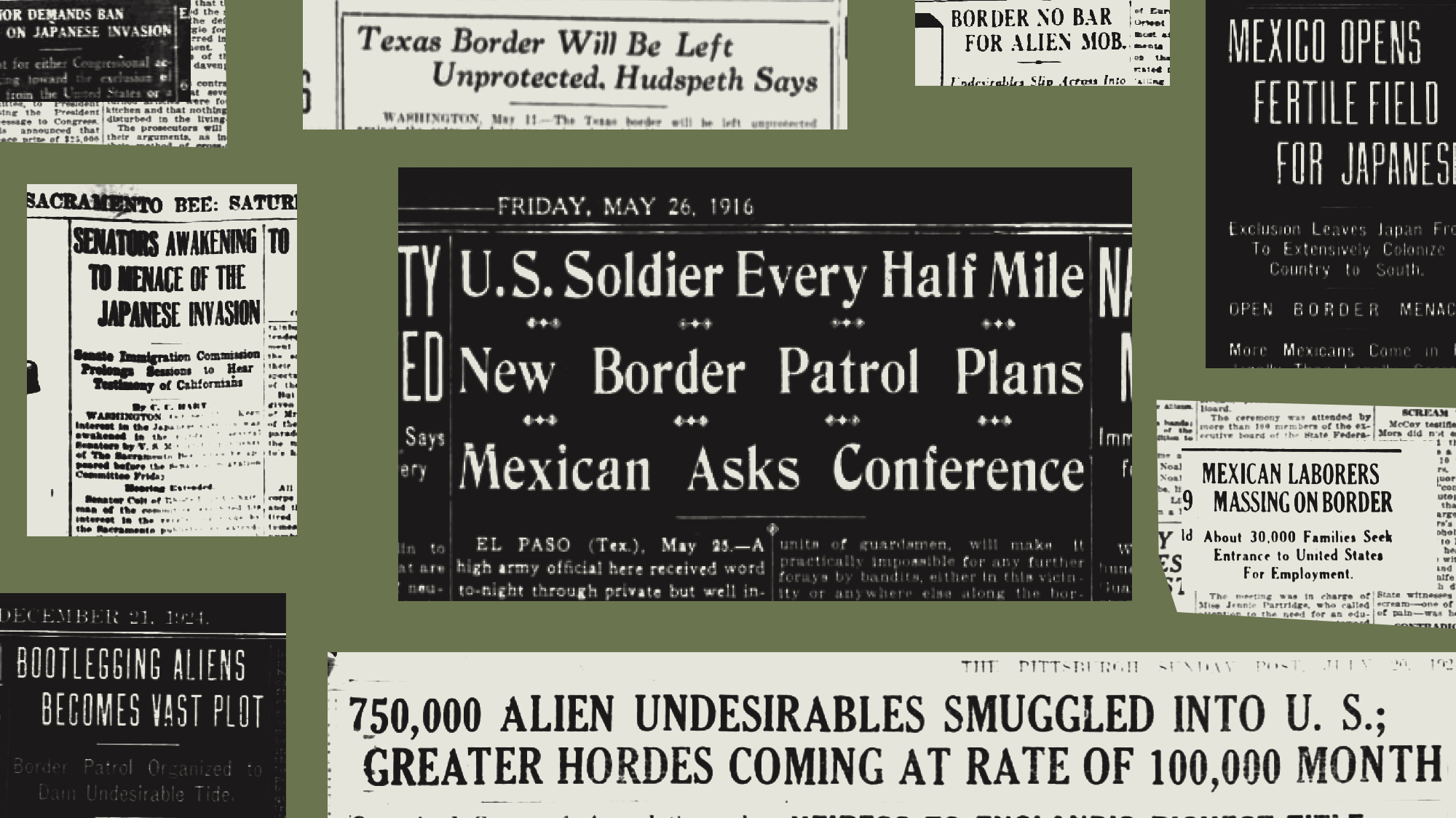
The effort was tabled, but he kept at it. “I have a resolution before this committee, as you gentlemen know, to establish and to reinforce the border patrol in Texas,” Hudspeth told the committee in 1920. “Why? To keep out the Jap and to keep out the Chinaman…I stand here today ready to urge that resolution, because, Mr. Chairman, I stand for law and order and I have stood for it all my life.” He would do everything he could, he said, “to keep the ‘wetback’…from coming across.”
A colleague asked Hudspeth if the Rangers who currently served on the border could pass a civil service exam.
“If the test was right in shooting, I know they could stand it,” he said. “They would get 100 percent.”
Hudspeth, who decried the federal government’s plan to roll back its troop presence on the border, was not the only one talking seriously about a more robust operation. In the Senate, another border lawmaker, Sen. Henry Ashurst (D-Ariz.), pushed a proposal for increased Army patrols, while at the same time calling for parts of Mexico to be annexed. Sen. James Phelan (D-Calif.) led a more pointed charge for increased funding for an immigration border guard. A former mayor of San Francisco who had run for office on the slogan “Keep California White,” Phelan believed the country faced demographic death.
“If we can stop Japanese immigration absolutely and guard our borders…the white man will have a chance to regather his strength and occupy the soil,” he declared at a 1919 hearing.
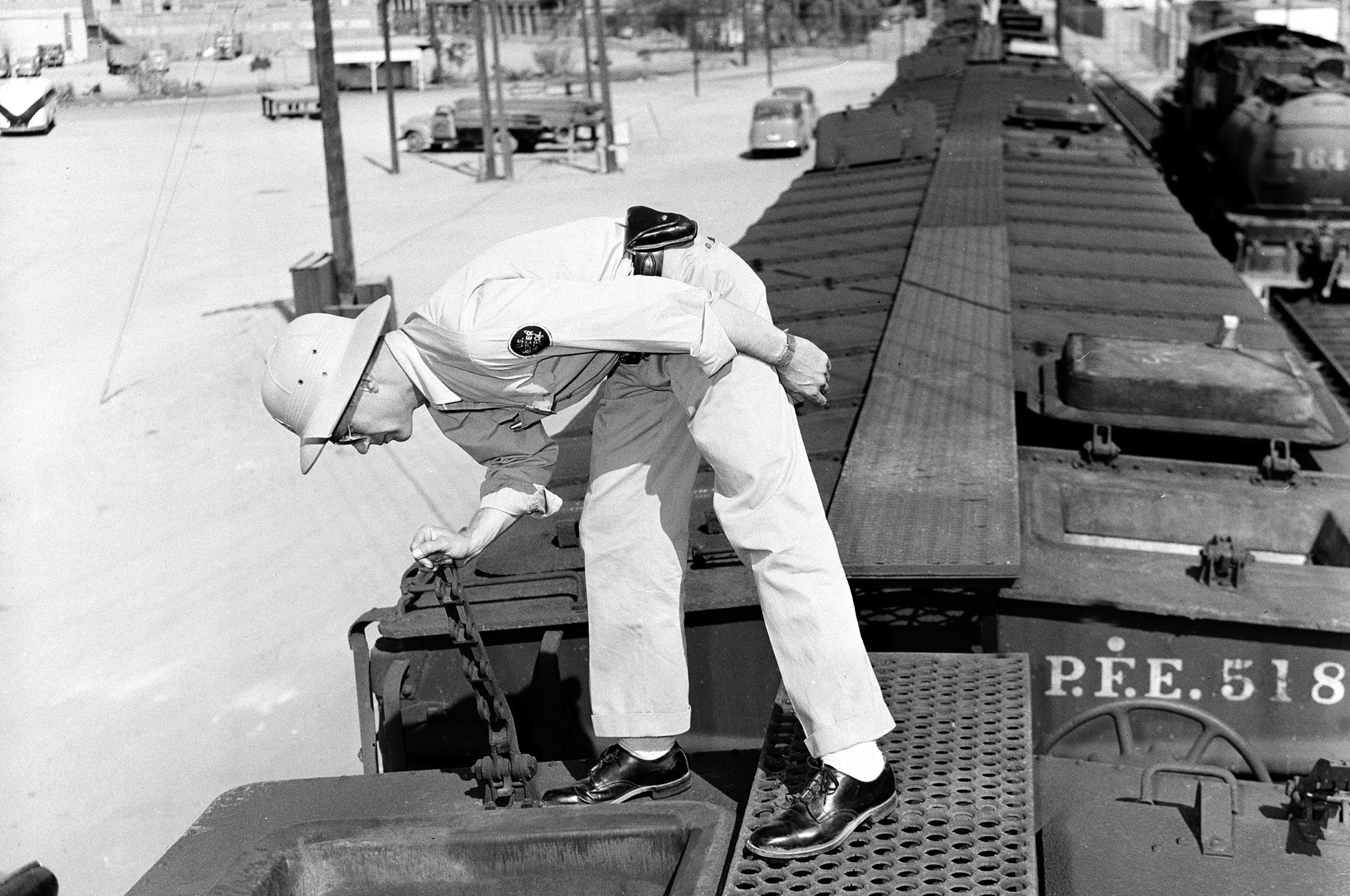

His colleagues were largely sympathetic to Hudspeth’s efforts. “We realize the menace that exists in permitting the Texas-Mexico border to be free to radicals and Reds and we intend to protect this border,” a committee member reassured the Texan in 1919. But the proposal languished. Budgets were tight and provincialism was strong. Some congressmen wanted to focus on Ellis Island instead—most immigrants, after all, arrived at ports. Even proponents of the idea acknowledged that trying to stop everyone might prove impossible.
“I do not want to be understood as assuming that we can make that border watertight,” Anthony Caminetti, the US immigration commissioner—and a former member, Lee notes in At America’s Gates, of a California white supremacist group that was later known as the Order of Caucasians—testified in 1919, while asking for money for more immigration agents. “We cannot do it. It would cost too much money.”
For Hudspeth’s dream to become a reality, Congress would have to settle a larger debate, about whom a Border Patrol should stop.

At the same time Hudspeth was beating his Border Patrol drum, he was pushing to ease restrictions on a particular group of border crossers. His constituents may have been fed up with Mexican smugglers and bandits, but in 1919 they were desperate for cheap labor. Hudspeth, who spent much of his time in Washington micromanaging his livestock and pecan operations, considered the head tax and literacy test too onerous for Mexican farmhands. He repeatedly pushed Congress and the White House to suspend its regulations. To Hudspeth, this was a matter of simple economic sense—even if he considered Mexicans “an inferior race.”
But when Hudspeth appeared before the immigration committee to make his case, he faced serious resistance. Republican Rep. Hays White of Kansas warned that Mexicans would bring an “evil philosophy against capital and property”—that is, communism. Another Republican, Colorado Rep. William Vaile, worried that the move would sacrifice “race integrity.” “They are wretched, lawless, poor criminal devils that do not know how to keep within the law,” said John Box, an East Texas Democrat, who argued that politicians were using Mexican and noncitizen voters to rig elections.
The committee’s Republican chairman, Albert Johnson of Washington, captured the spirit of the House: “Is it not time for the United States to look upon every outsider with suspicion?” he asked Hudspeth.
Johnson and many of his peers believed the answer was yes. Rather than relaxing rules, they wanted to tighten them. There was no secret about why: Johnson, like many of his colleagues, despised Southern and Eastern Europeans and was deeply antisemitic. He and his allies proposed a new quota system to restrict immigration by tying the number of people admitted from each country to that nationality’s representation in the 1890 Census—before the surge in migration from the targeted areas. His immigration committee even hired an in-house Eugenics Expert Agent—a proponent of mass sterilization who believed that Jews were “filthy, un-American, and often dangerous in their habits.”
“Is it not time for the United States to look upon every outsider with suspicion?” asked the immigration committee’s Republican chairman.
While Johnson had resisted Hudspeth’s efforts to loosen restrictions on Mexicans entering the country for seasonal work, it was the chairman’s 1924 National Origins Act that finally pushed the Border Patrol over the finish line. The law slashed non–Western European migration and practically zeroed out emigration from Asia but exempted the Western Hemisphere. The interests of farmers and ranchers like Hudspeth ultimately prevailed over the wishes of people like Box and West Virginia Democratic Sen. Matthew Neely (who stated that “we shall have delivered all of our priceless heritage to foreign invaders”). Agribusiness wouldn’t stand for a restriction that would threaten their labor supply, and politicians argued that extending the quotas would jeopardize diplomatic relationships. Even some of the eugenicists had to admit that attempting to keep out people who share a border would be too big of a lift.
Nativists “were absolutely livid that Congress didn’t pass any outright restrictions on Mexicans,” says Kang, the UVA professor. “Congress compromised and said, ‘Look, we’ll create the Border Patrol so we can control Mexican migration and make sure their migration is a temporary one.’”
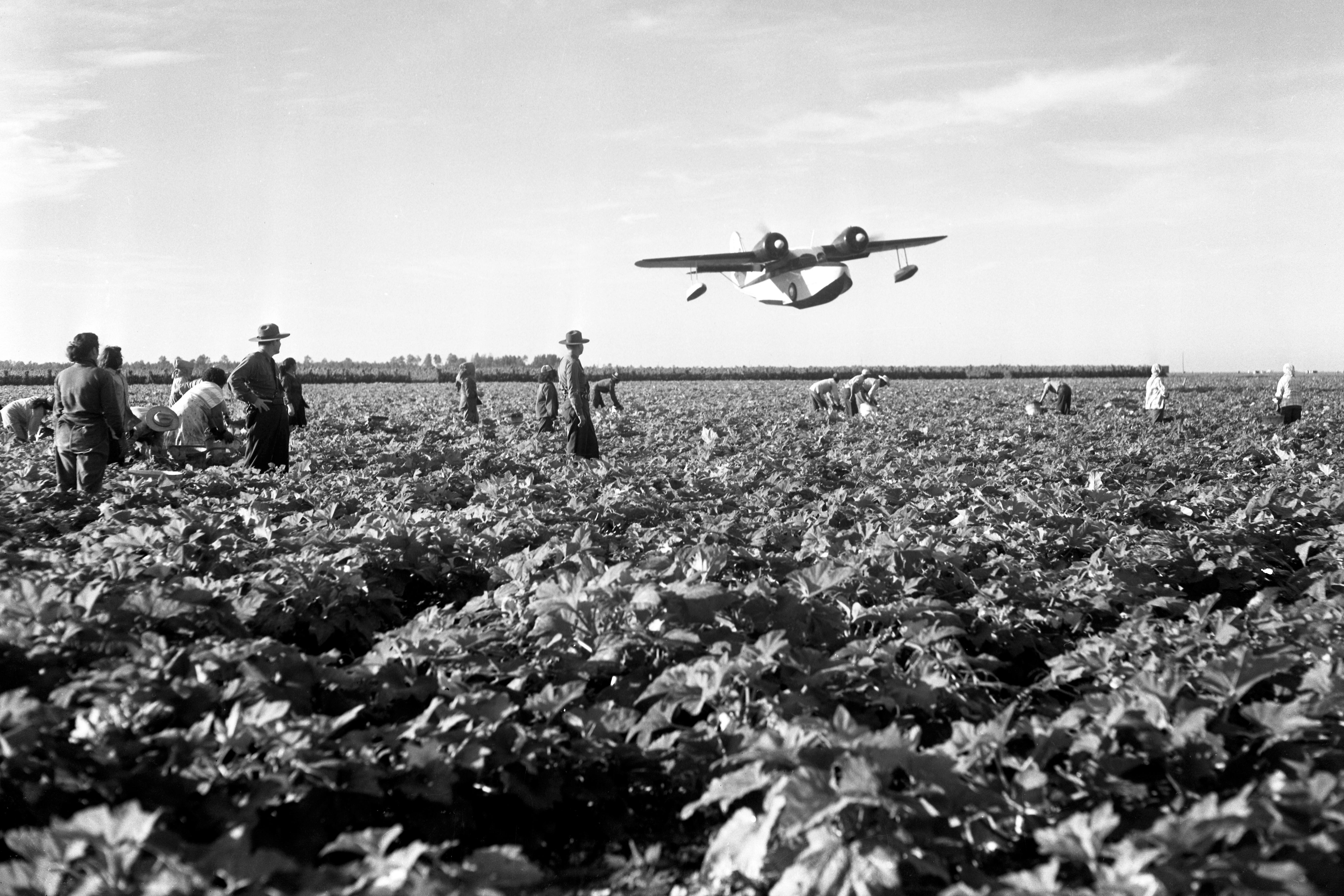

The National Origins Act included a clause specifically authorizing the appropriation of funds for its enforcement, and with that in hand, Johnson and Hudspeth introduced competing Border Patrol appropriations into an omnibus spending package working its way through the House. This time they found an ally in Box, who argued in a brief speech defending the measure that a new force was needed to keep “vicious and undesirable” immigrants from crossing the Mexican border—and falsely asserted that the previously deported anarchist Emma Goldman had recently “entered in that way.” Hudspeth’s amendment, which asked for more money, ultimately prevailed. But in a reminder of the history of exclusion underpinning the effort, the chairman first had to amend the bill’s language to say “aliens” instead of just “Chinese.”
In the runup to the final passage, media accounts depicted a crisis. Mexicans were “massing on the border,” one Texas newspaper reported. A wire service story in late May 1924 read like early border agitprop, featuring photos of immigration inspectors in action, hiding in the brush with their weapons ready. “Two aliens were found under the pile of sacks in this wagon after it crossed the American border,” one caption read. Another photo featured what looked like staged footage of “federal authorities” engaged in a shootout with “Chinese smugglers” on the Arizona border.
In the run-up to the final passage, media accounts depicted a crisis. Mexicans were “massing on the border,” one Texas newspaper reported.
“They are doing what they can,” the story announced. “But the job is too big. Passage of the Hudspeth appropriation bill, now pending in Congress, is their only hope.” The package became law the next day, on May 28, 1924.
The Border Patrol was a new idea that bore the distinct imprint of the past. To fill its roster, the force relied on the institutions that had been policing the color line for years. In Migra! A History of the U.S. Border Patrol, historian Kelly Lytle Hernández found that many of the first recruits were drawn from the Texas Rangers. The director of the sector that included Laredo, William Hanson, was an ex–Ranger captain who had spied on Black political dissidents, smuggled guns to Mexican counterrevolutionaries, and fanned fears of an armed invasion of Texas. For its part, the Border Patrol today considers Berkshire its “Father”—the unit’s early ranks were filled, too, with ex–Chinese Inspectors like him.
But in their haste to authorize the force, Hudspeth and his colleagues had neglected to give it anything to do. At first, agents didn’t even have the authority to arrest anyone. No sooner had the first agents donned their forest green uniforms than the calls began again. The border guard needed more power, more men, and more funding. Congress meant to solve a problem. It only created bigger ones.
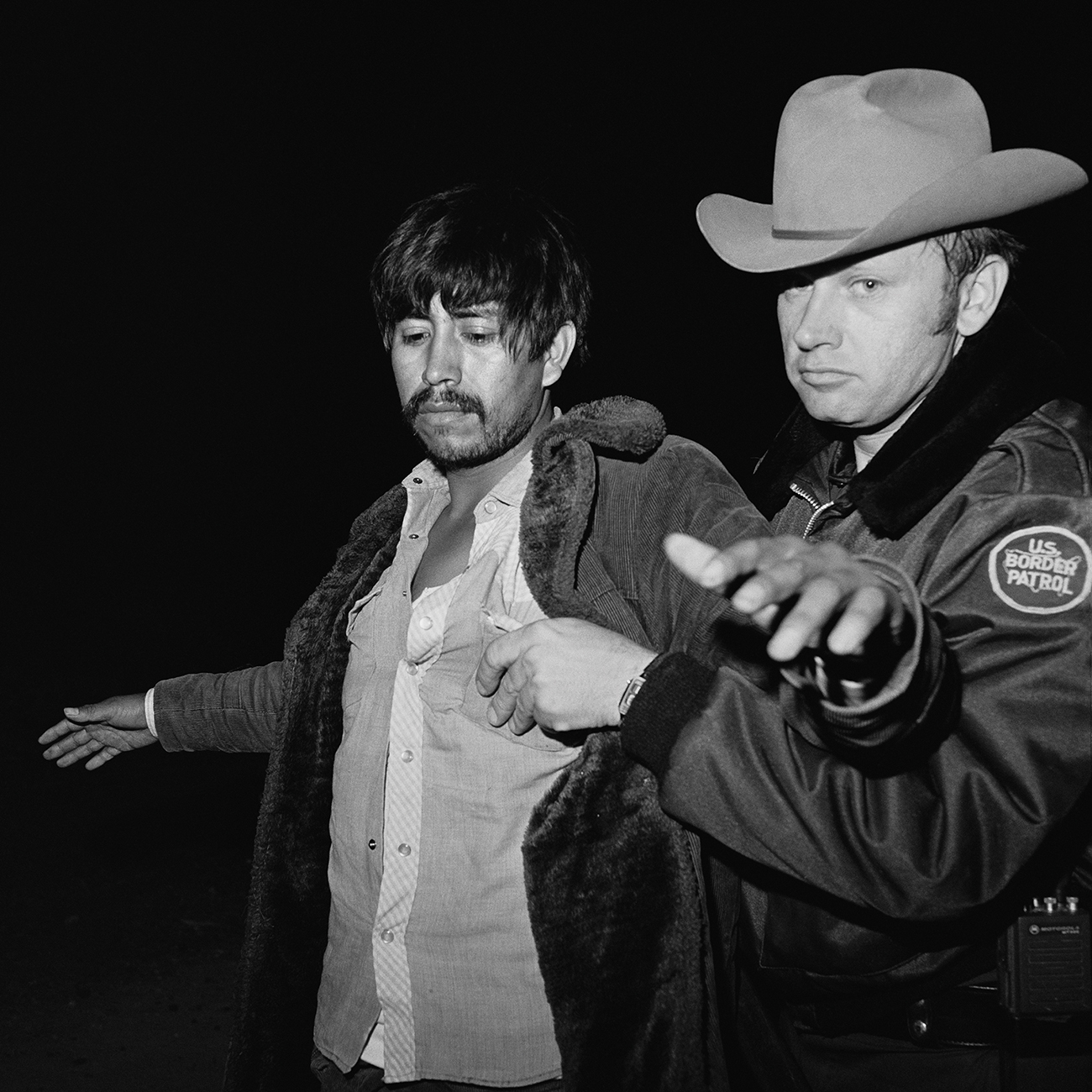

For someone whose handiwork is foundational to American politics today, Hudspeth is largely anonymous. The Border Patrol Museum makes no mention of the force’s first political patron, just as it steers clear of the period of state violence that preceded the unit’s creation and the eugenicist nature of the debates from which it finally emerged. Hudspeth’s obituaries upon his death in 1941 skipped right over his role in creating the agency. It is possible he simply never envisioned its full significance; his papers at the University of Texas at El Paso—another institution he helped found—include nary a reference to his role in establishing what is now a sprawling force of nearly 20,000 people.
But there is one monument to his legacy. When Hudspeth was only 39, in the middle of his push for the Ranger bill, his colleagues honored him with a gift: They named a county for him—a remote patch of West Texas that today is home to some 3,400 people in an area more than twice the size of Delaware. The county is a destination not just for millions of dollars of state and federal funds, but for right-wing border cosplayers. In 2011, Steven Seagal was sworn in as a sheriff’s deputy. Hudspeth’s historic marker sits on a sunbaked rest area off I-10. You can’t miss it; it’s the last stop before the Border Patrol checkpoint.
Hudspeth’s obituaries upon his death in 1941 skipped right over his role in creating the Border Patrol. It is possible he simply never envisioned its full significance.
In recent years, as walls and patrol strategies pushed migrants into ever more hostile corridors, Hudspeth County has seen an unprecedented surge in apprehensions and deaths. One of the biggest employers outside the BP is the West Texas Detention Center, part of the region’s booming migrant-jail economy. In 2022, the now-former warden at one of those detention centers was released on bond with his brother after allegedly killing a man from Mexico who stopped to drink from a small pond. “They are good guys,” the sheriff told the New York Times.
Hudspeth did not begin this process; he merely did his part to keep it going. The work could never be finished. Which was why, in February 1925, less than a year after his force was established, Hudspeth returned to the House Appropriations Committee with another proposal. He began, in earnest, to discuss a new problem facing the ranchers and lawmen of his district. East of El Paso, the river had jumped its channel years ago and left pockets of Mexican territory north of the Rio Grande. Now, with Prohibition in effect, the area was overrun by smugglers. The Border Patrol was outgunned. “In the last two years we have had something like 20 government officials murdered there,” he testified. Hudspeth was asking for $30,000 to settle the problem.
“What is it you want?” a committee member asked.
“I want a fence,” Hudspeth replied.
Read the rest of our Border Patrol investigation here.
Credits from left: Universal History Archive/Universal Images Group/Getty, Lennox McLendon/AP, Keystone-France/Gamma-Keystone/Getty, Library of Congress/Wikimedia

